Determining the perfect moment when beef jerky is ready to enjoy involves a blend of sensory observation, common sense, and a touch of expertise. While professional jerky factories rely on precise equipment to measure internal temperatures and water activity levels, home jerky makers can achieve similarly satisfying results by focusing on smell, taste, and visual cues. If you’re wondering how to know when beef jerky is done, the key is to identify when the jerky is cooked to an internal temperature of 160°F, dried to a water activity under 0.85, and exhibits distinct spider webbing at the tear or bend. After at least three hours in the dehydrator, cooling a piece of jerky for 5-10 minutes at room temperature will reveal its readiness, ensuring you savor beef jerky at its peak perfection.
5 Crucial Indicators for Perfect Beef Jerky
Knowing how to determine when your beef jerky has reached the perfect stage is essential for achieving that deliciously satisfying texture and flavor. These five key indicators will guide you through the process and ensure your jerky is done to perfection:
- Cook Time and Temperature Have Been Precisely Met
The foundation of great jerky starts with adhering to the right cooking time and temperature. When these are met without any deviations, you can be confident that your jerky is on the right path. - A Savory, Meaty Aroma Fills the Air
As the jerky slowly dries, it begins to emit a meaty, appetizing scent. This is a telltale sign that it’s on the right track, signaling that the drying process is progressing as it should. - The Fat Has Rendered, and the Jerky Appears Dry and Leathery
One of the signs of perfectly made jerky is that the fat has been rendered out, leaving behind a dry, leathery texture. The jerky will lose its raw, greasy feel and take on a firm, somewhat pliable consistency. - The Jerky Bends but Doesn’t Snap
At the right moment, your jerky will bend under pressure but won’t snap completely. Instead, it will break into a clean, tearable piece when bent, indicating the correct texture balance. - The Jerky Tastes Dry
Finally, the flavor of well-made jerky is unmistakable—it should taste dried, with no excess moisture left behind. A dry, concentrated flavor is the hallmark of jerky that has been properly prepared.
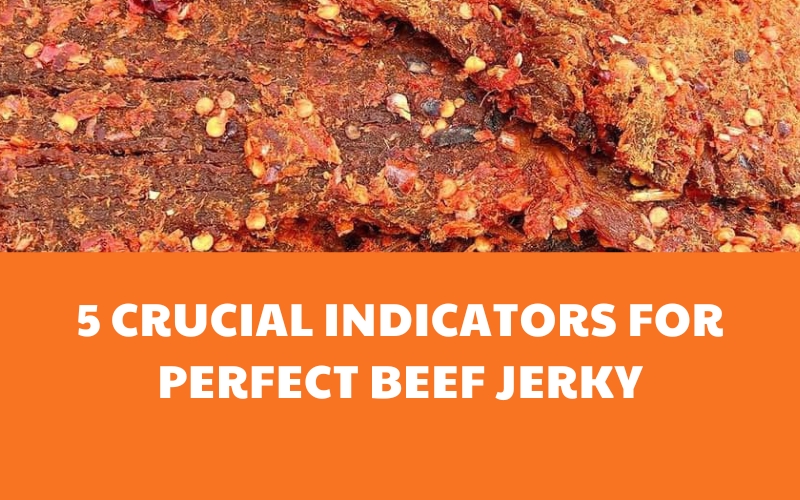
Now that you know the steps, you’ll never have to wonder again about how to know when beef jerky is done. Armed with this knowledge, you can confidently tell when your jerky is at its peak, ready to enjoy.
Achieving the Right Cook Time & Temperature: The First Crucial Step
When making beef jerky, ensuring that the cook time and temperature are adhered to precisely is one of the most important factors in determining its doneness. Trusted beef jerky recipes are carefully designed with specific time and temperature guidelines to ensure the meat is fully cooked and safe to eat. The key is in using a trusted recipe—one that has been tested and perfected over time to guarantee delicious and properly cooked jerky.
For example, our beef jerky recipes have undergone rigorous testing, including repeated tastings and evaluations. These trials are essential for ensuring a consistently perfect outcome, so you can rest assured that the jerky you make will be flavorful and fully cooked.
Why is this step so crucial? It’s because there’s no universal formula for the right combination of time and temperature when making jerky. The United States Department of Agriculture (USDA), the governing body that oversees meat production in the U.S., provides detailed Cooking Guidelines that outline various time and temperature combinations to achieve “lethality.” Lethality is an industry term for the process that ensures the meat is safely cooked and free from harmful pathogens, making it safe for human consumption.
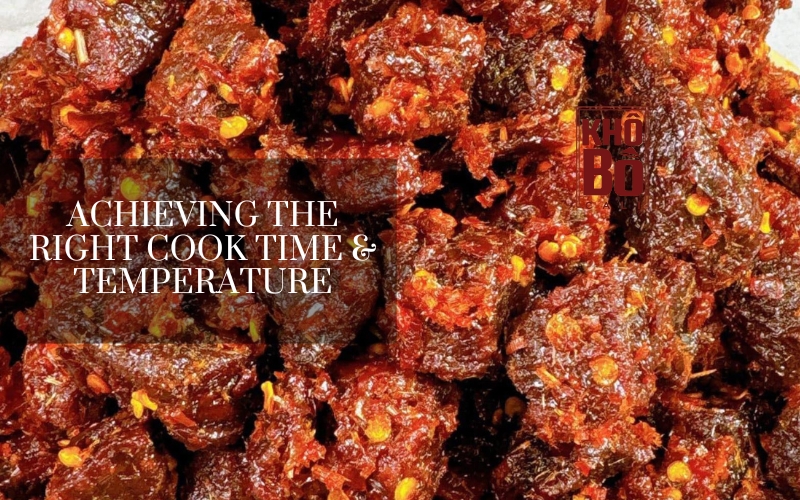
It’s important to note that these USDA guidelines focus on the internal temperature of the meat, not the surface or the oven temperature. This is where some confusion can arise, as people may assume that the oven temperature alone guarantees the jerky is properly cooked. In reality, the key to cooking jerky is reaching the correct internal temperature.
For those wondering how to know when beef jerky is done, achieving the appropriate internal temperature is vital. You can either cook the meat at a lower temperature for a longer period or at a higher temperature for a shorter period. As long as you reach and maintain the required temperature for the recommended amount of time, you can be confident the jerky is safe and cooked. However, keep in mind that these guidelines ensure the meat is cooked but not necessarily dried—another critical consideration in making jerky.
For jerky sliced to a 1/4 inch thickness, we typically recommend cooking at 165°F for 4-5 hours. Yet, even when following these instructions, various factors beyond your control can influence the outcome, which is why the next steps in the jerky-making process are also essential. If you’ve managed to cook the jerky according to the exact time and temperature specified in your recipe, without any fluctuations, you’re ready to move on to the next crucial step in determining its doneness.\
>> Readmore: Spicy beef jerky – the ‘national snack’ that evokes nostalgia and fond memories
The Jerky Begins to Release a Rich, Meaty Aroma
One of the most obvious and satisfying signs that your beef jerky is nearing completion is the aroma. As the meat cooks, a rich, savory smell fills the air—a sign that the jerky is cooking to perfection. This smell is more than just an indicator; it’s a sensory cue that the transformation is taking place inside the jerky.
The appetizing aroma you detect is the result of a chemical process known as the Maillard reaction, which occurs when heat causes sugars and proteins in the meat to react. According to experts at Serious Eats, “The Maillard reaction is many small, simultaneous chemical reactions that occur when proteins and sugars in and on your food are transformed by heat, producing new flavors, aromas, and colors.”

It’s the Maillard reaction that gives us the delicious, toasty, and umami-packed flavors and smells we associate with cooked food. If you’ve ever enjoyed a perfectly seared steak, a fresh loaf of bread, or a cup of freshly brewed coffee, then you’ve experienced the Maillard reaction in action. It’s the reason for the deep, nutty, and roasted flavors that develop when cooking.
While the Maillard reaction generally takes place at higher temperatures, between 280°F and 330°F, it can also occur at lower temperatures if the cooking process is prolonged. This is the same reaction responsible for the aging and ripening flavors in cheeses, and it plays a pivotal role in the creation of the complex flavors and aromas in beef jerky, particularly when it’s cooked low and slow.
So, when your dehydrator, oven, or smoker starts to emit an irresistible, meaty fragrance, you’ll know you’re either very close to the finish line or the jerky is fully cooked and ready for the next step in determining how to know when beef jerky is done. The smell is your cue to check in on the jerky’s progress and gauge whether it’s reached that ideal point of doneness.
>> Readmore: Does beef jerky need to be refrigerated?
Rendered Intramuscular Fat and the Jerky’s Dry, Leathery Finish
At this stage, it’s time for a visual inspection—your first “eyeball test” to see if the jerky has achieved the desired texture and appearance. To get the most accurate read on its doneness, remove a piece from the dehydrator, smoker, or oven and allow it to cool for a few minutes. Freshly cooked jerky can appear deceptively different when it’s still warm, so waiting for it to cool to room temperature is crucial in accurately assessing its readiness.
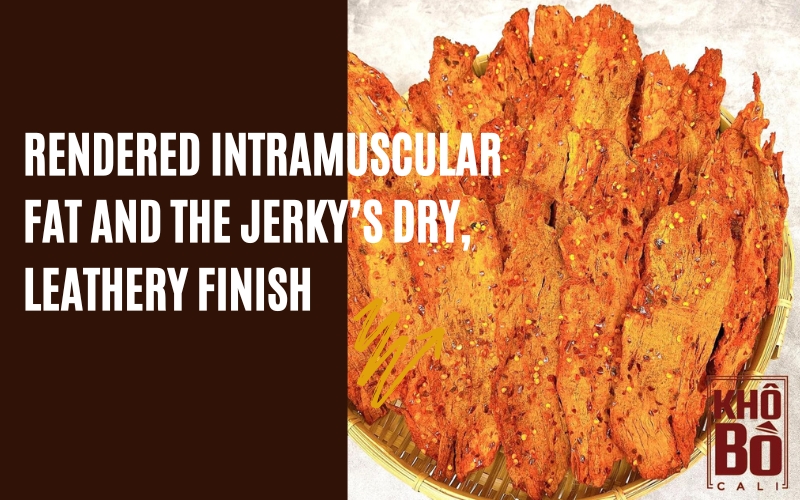
Once your jerky has cooled, there are a few key visual indicators to look for that will tell you if it’s perfectly done:
- A Dry, Leathery Surface
The jerky should have a distinct dry and leathery appearance, devoid of any wet or sticky spots. The surface should look firm yet pliable, with no signs of excess moisture. This dry, tough exterior is a hallmark of jerky that has been thoroughly dehydrated and is ready to eat. - Rendered Intramuscular Fat
One of the most telling signs of well-made jerky is the rendering of intramuscular fat. Any fat within the meat should be fully rendered and cooked out, leaving behind a smooth, dry texture. If there’s any remaining fat, it should take on a rich, golden-brown hue. This means the fat has been properly rendered and no longer poses the risk of undercooking. However, if you notice that the fat is still white or ivory in color, this indicates that the jerky needs more time in the dehydrator or oven. - No Excess Moisture or Wet Marinade
The jerky should not have any excess moisture from the marinade clinging to its surface. While a small amount of grease or rendered fat is perfectly normal and will impart a slight sheen to the jerky, any residual liquid or wetness on the outside of the jerky suggests that it hasn’t been fully dried. The absence of excess moisture is a key sign that the jerky is nearly or fully done.
This visual inspection will give you valuable clues in determining how to know when beef jerky is done. By ensuring that the jerky looks dry, leathery, and free from residual fat or moisture, you can confidently proceed to the next phase of the jerky-making process.
The Bend-and-Break Test: The Ultimate Measure of Doneness
Among the various methods for determining if your beef jerky is ready, the “bend test” stands out as one of the most reliable and straightforward techniques. This simple test allows you to evaluate the jerky’s texture and dryness by observing how it reacts when bent. It’s a foolproof way to gauge how to know when beef jerky is done without the need for specialized equipment.
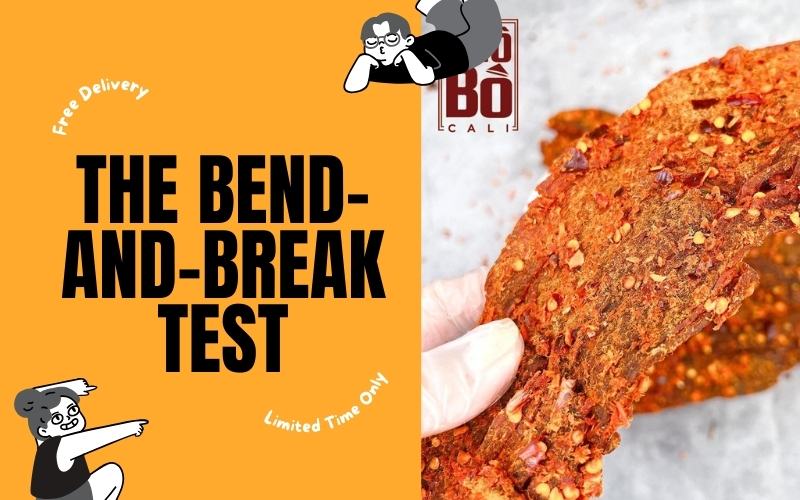
To perform the bend test, select a piece of jerky that has cooled to room temperature. Warm jerky can be misleading as the heat may temporarily soften its texture, making it harder to determine the actual level of dryness. Once cooled, follow these steps:
- Bend the Jerky
Take the piece of jerky and slowly bend it in half. Pay attention to the resistance and flexibility of the meat as you apply pressure. - Look for Controlled Breaking
When the jerky is perfectly done, it should bend without snapping immediately. Instead, it will eventually break at the fold, revealing fibrous strands of meat within. This controlled break is a hallmark of properly dried jerky—dry enough to be preserved, but not so dry that it crumbles or loses its chewy texture. - Identify Signs of Under- or Over-Drying
If the jerky remains rubbery and refuses to break when bent, it’s a clear indication that it needs more time in the dehydrator, oven, or smoker. On the other hand, if the jerky snaps cleanly into two pieces without any bending, it has likely been over-dried, which can result in a brittle texture and diminished flavor.
The bend-and-break test is a tactile, hands-on approach that provides immediate feedback on your jerky’s doneness. By mastering this simple technique, you’ll gain confidence in knowing how to know when beef jerky is done and can ensure your jerky achieves the perfect balance of chewiness and dryness.
The Ultimate Test: Taste the Jerky
Saving the most enjoyable test for last, tasting your jerky is not only a reward for your effort but also one of the most effective ways to determine how to know when beef jerky is done. Your palate is your greatest ally in confirming whether your jerky has reached the desired level of dryness and flavor.
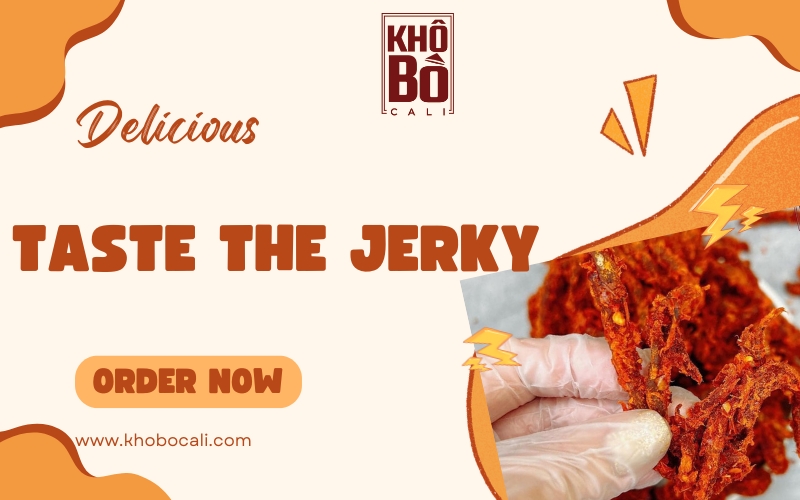
To conduct this final assessment, start with a small sample piece that has cooled to room temperature. Cooling is essential because the jerky’s warmth can mask its true texture and dryness. Here’s how to proceed with the taste test:
- Assess the Texture
Take a bite of the jerky and pay close attention to its texture. Properly dried jerky will have a firm, chewy consistency that pulls apart with effort but doesn’t feel overly tough. It should taste dry and lack any residual internal moisture that might remind you of a steak or cooked meat. If the piece feels soft, juicy, or retains a steak-like quality, it’s an indication that the drying process isn’t complete. - Evaluate the Flavor
The flavor of your jerky should be concentrated and intense, with all the spices and seasonings melding harmoniously into the meat. Underdone jerky might taste slightly bland or diluted due to the remaining moisture that hinders the full flavor development. - Trust Your Instincts
Ultimately, you are the final judge. If the jerky meets your expectations for dryness and taste, it’s done. If not, remember that it’s always better to err on the side of caution. You can return the jerky to the dehydrator, oven, or smoker for additional time if needed. Drying it further will enhance its shelf life while ensuring safety for long-term storage. - The Link Between Dryness and Longevity
Keep in mind that the drier the jerky, the longer it will last. Achieving the perfect dryness ensures not only a satisfying eating experience but also extends the storage potential of your homemade snack.
This final step is both practical and satisfying, offering you the most direct confirmation of how to know when beef jerky is done. By tasting and trusting your senses, you’ll ensure your jerky is both delicious and perfectly preserved.
Final Thoughts: Perfecting Your Beef Jerky
By the time you’ve followed your recipe to the recommended cooking time and temperature, your beef jerky will almost certainly be fully cooked and safe for consumption. At this stage, your primary focus shifts from cooking to drying—a crucial step that ensures the jerky becomes shelf-stable and achieves the perfect texture.
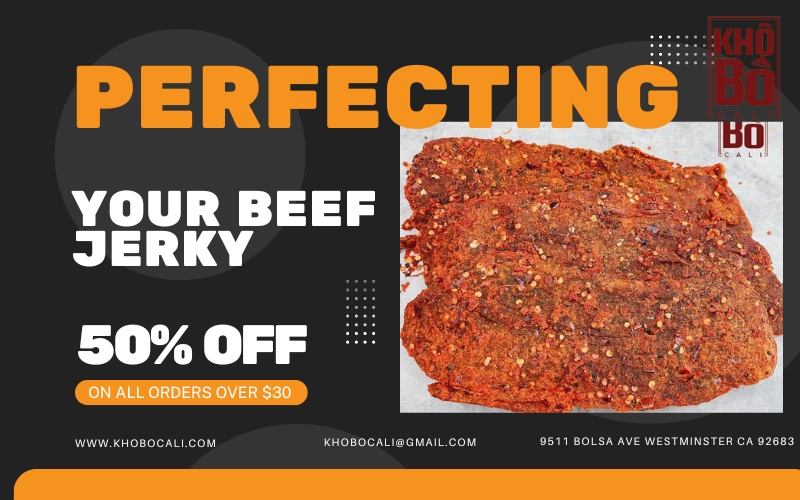
However, even with a meticulously followed recipe, individual factors like meat thickness, humidity levels, and equipment variations can impact the drying process. So, how do you proceed if your jerky isn’t quite ready? Here’s what to keep in mind as you refine how to know when beef jerky is done:
- Patience is Key
If your jerky doesn’t meet the desired dryness criteria on the first check, don’t worry—this is completely normal. Simply return it to your dehydrator, smoker, or oven and allow it to continue drying. Set a timer and check back at regular intervals (every 10–15 minutes) to ensure the process is progressing smoothly. - Adjusting for Perfection
The beauty of jerky-making lies in its flexibility. It’s always better to add drying time gradually rather than risk over-drying your batch. Once the jerky is over-dried, it can become brittle and lose the chewiness that defines a perfect piece. This step-by-step approach allows you to find that sweet spot where your jerky is flavorful, chewy, and long-lasting. - Know the Indicators
Remember the key markers of doneness: a leathery, firm texture; rendered fat; an appetizing aroma; and, of course, the results of the bend test. Combine these sensory observations with a final taste test to confirm that your jerky meets your expectations. These indicators will help you master how to know when beef jerky is done with confidence. - Why Drying Matters
Achieving the right dryness isn’t just about texture—it’s also about safety and preservation. Properly dried jerky can be stored for weeks or even months, making it an ideal snack for adventures or emergencies. Underdried jerky, on the other hand, can spoil quickly, compromising both its flavor and safety.
By being patient and thorough in this final stage, you’re not just finishing the process—you’re ensuring that all your hard work pays off in the form of delicious, long-lasting jerky. Mastering these final checks will not only elevate the quality of your jerky but also make the process more enjoyable and rewarding.
Mastering the Art of Jerky-Making

Learning how to know when beef jerky is done is the cornerstone of crafting the perfect homemade snack. By combining visual cues, sensory observations, and a little patience, you can consistently achieve results that are safe, delicious, and packed with flavor. Whether you’re perfecting your first batch or refining your technique, these steps serve as your reliable guide. Embrace the process, trust your instincts, and enjoy the satisfaction of making beef jerky that’s as good as—or even better than—the pros.



[…] >> Readmore: How to Know When Beef Jerky Is Done: Unlocking the Perfect Texture and Flavor […]
[…] >> Readmore: How to Know When Beef Jerky Is Done: Unlocking the Perfect Texture and Flavor […]